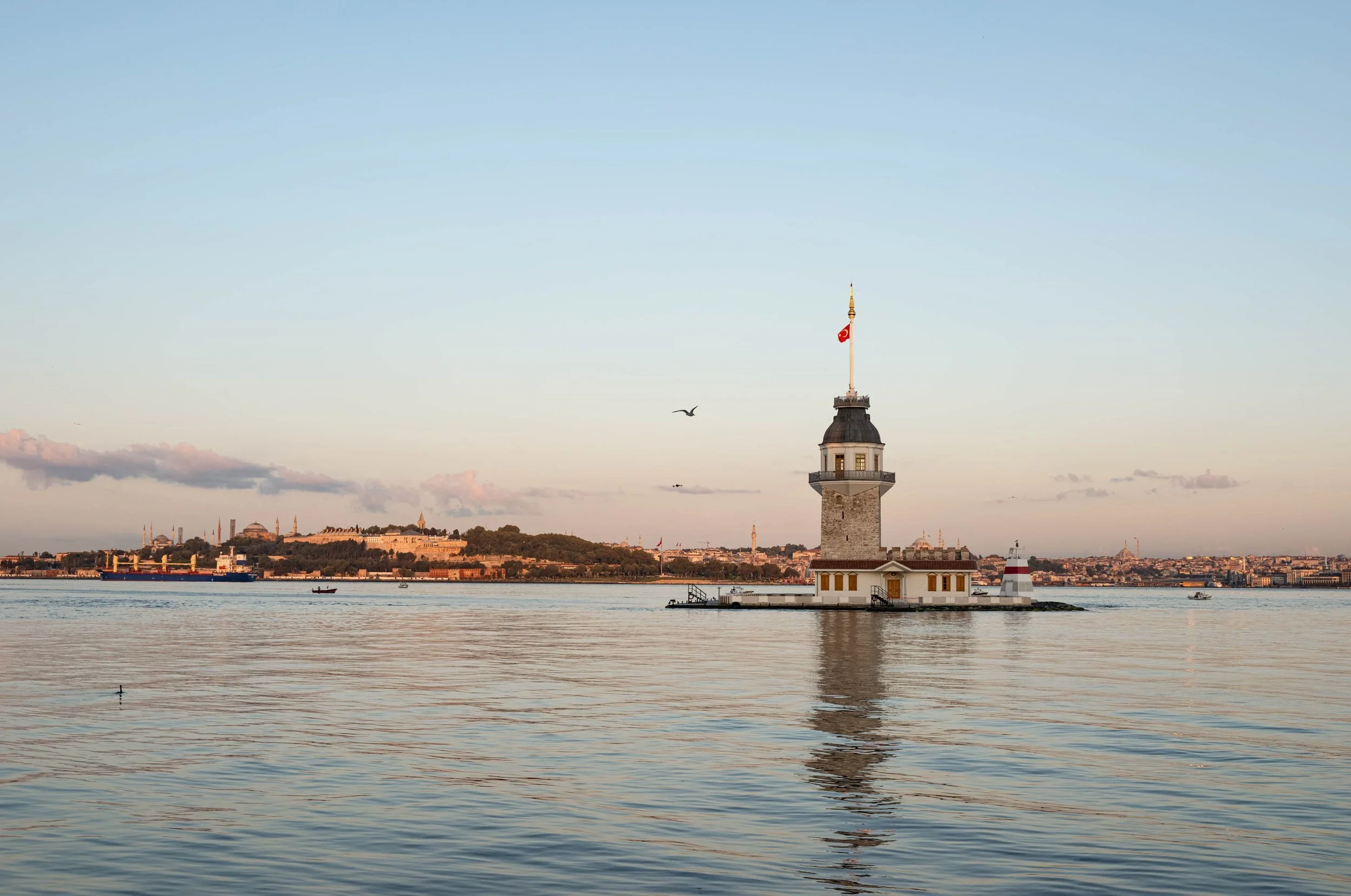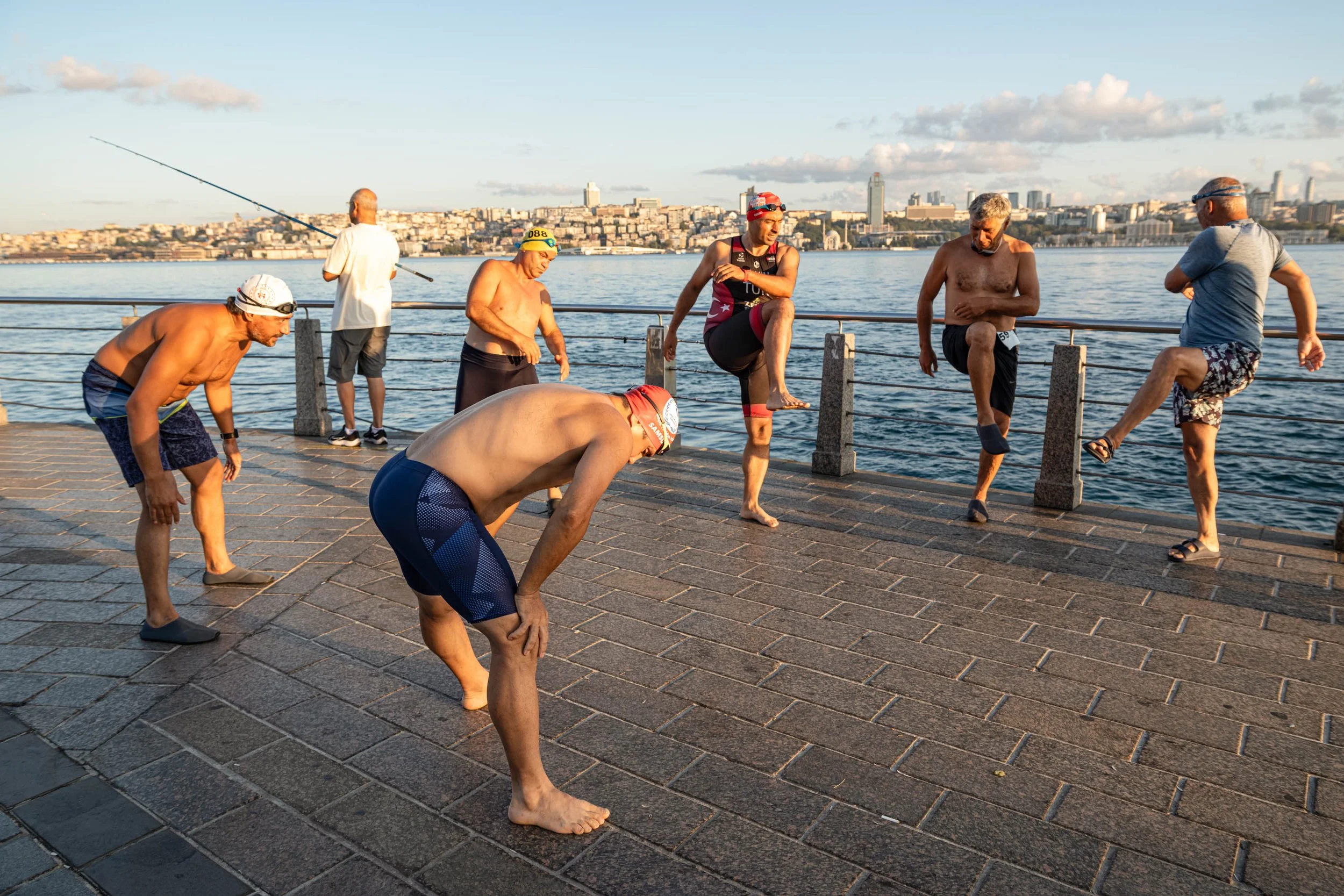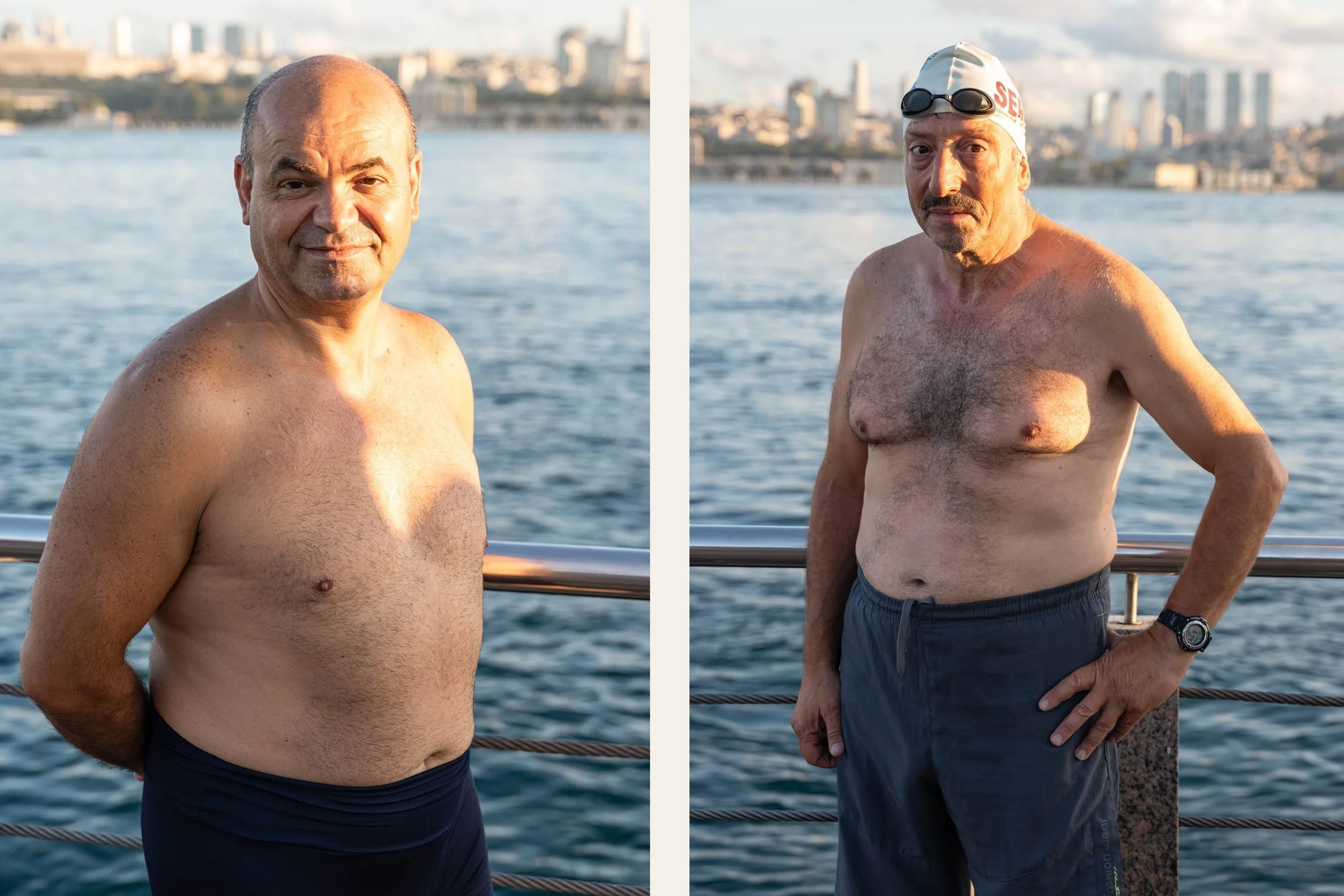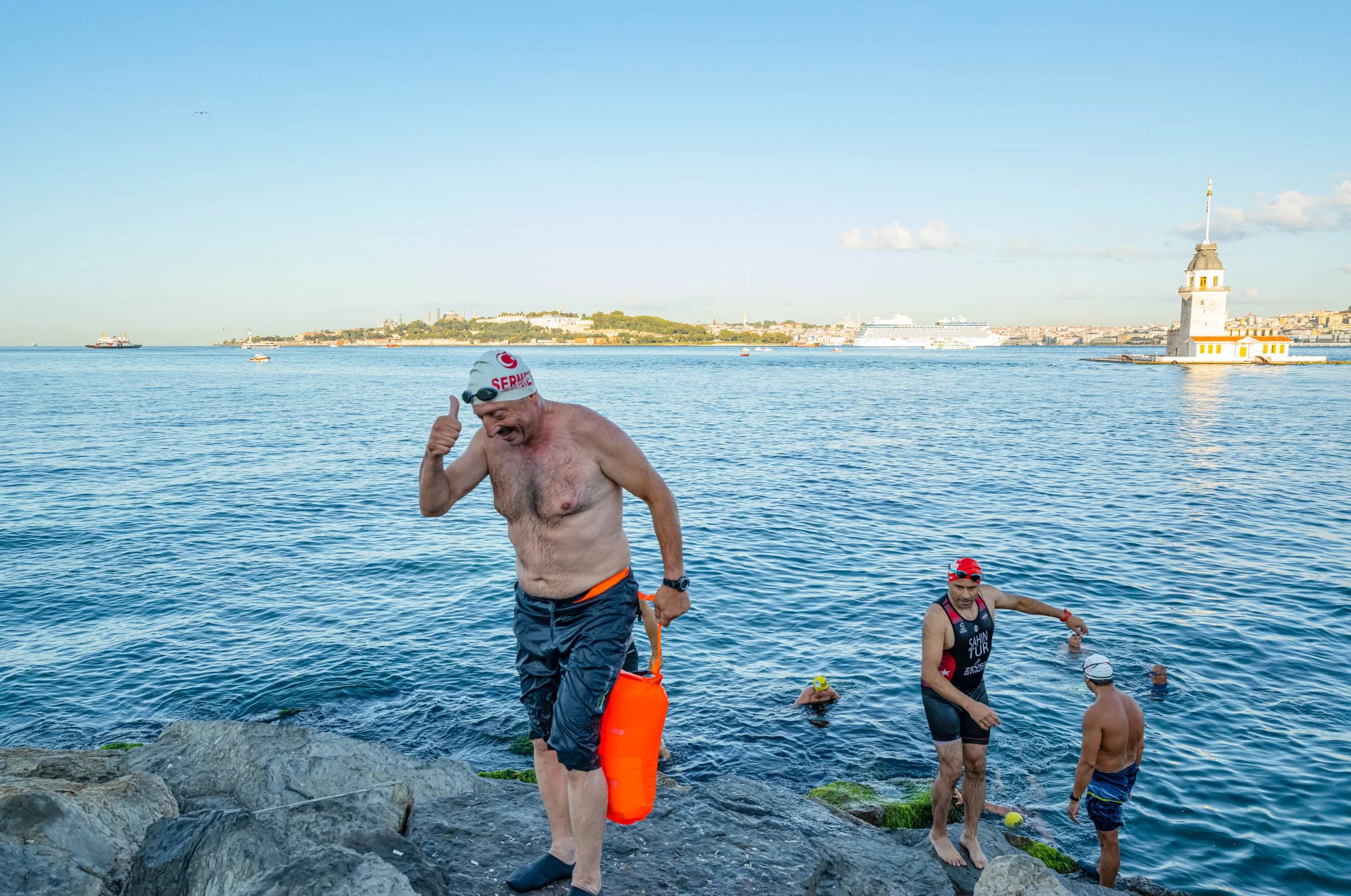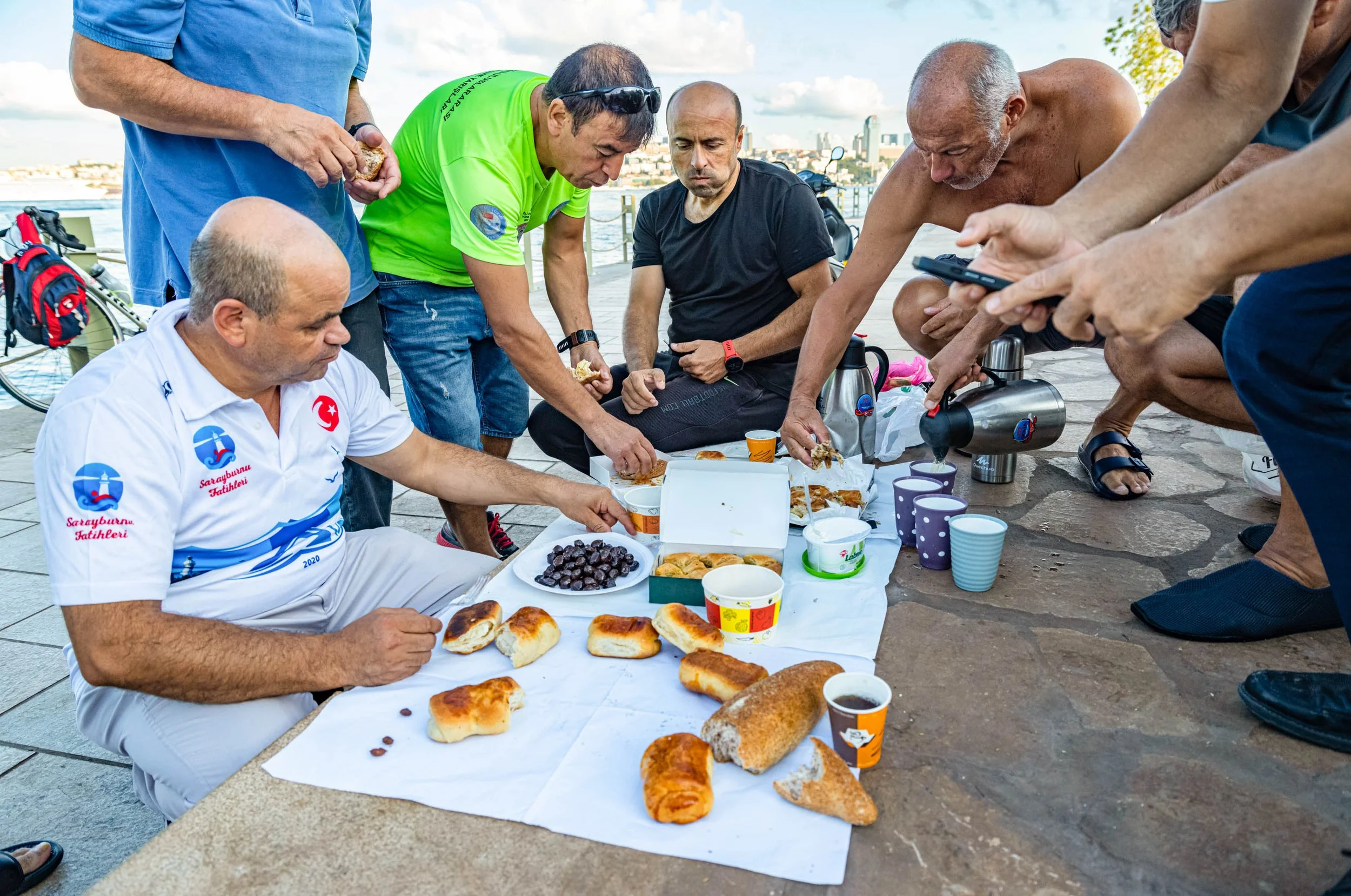My article for Vox Media’s now-shuttered Thrillist in which I dive into Istanbul's Bosphorus Strait alongside the Sarayburnu Fatihleri, a group of devoted locals who have turned swimming in and across this historic waterway into a daily ritual. This one was close to my heart. Read the article here or down below in full. all photos by the wonderfully talented Rena Effendi.
It’s 7 am on a breezy August weekday as we plunge into Istanbul’s iconic Bosphorus Strait from a boardwalk 10 feet above the waves.
This storied Turkish waterway divides the city into its European and Asian identities, stretching 20 miles from the Black Sea to the Sea of Marmara, where it flows out to the Dardanelles and into the jeweled Aegean Sea beyond. One hundred and thirty ships pass through the strait daily, and its bends and currents mean only the most skilled pilots can navigate it without running aground. As a swimmer, there’s even less room for error. People can and do drown here.
The dedicated group of eight Istanbul locals I’m taking the plunge with tell me the most important piece of advice is to stay calm. For them, the Bosphorus is more than just a hazardous waterway—it’s a daily ritual, a connection to history, and a way of life. The Sarayburnu Fatihleri, or Sarayburnu Conquerors, a loose collection of teachers, baklava chefs, and retirees who have been meeting on these shores for the past two decades, swim the strait almost every day at dawn. Though some pack their belongings into waterproof bags and swim their way from Asia to Europe to avoid the city’s grueling morning commute on their way to work, most just do it for the thrill. Most have been swimming in the strait since they were kids.
A few days after reaching out to the group, I find myself inducted into their morning ceremony: swimming to a small, rocky islet off the Istanbul coastline half a mile south. By the time I surface from the initial plunge off the boardwalk, I’m already several meters downstream. My quickening heartbeat is checked by the laughter and exaltation coming from the men scattered in the water around me. It seems I’m the only one worried about getting struck by any ships or being carried out to the open sea.
“How beautiful is this?” shouts Cemal Gümüş, a 50-year-old bank director, as we move away from the shore of the bustling Asian-side neighborhood of Üsküdar. He’s wearing a bright red swimming cap, goggles, and tight blue shorts with an underwater camera tied to his wrist to nab some videos for the group’s Instagram account.
It is, in fact, beautiful. As we swim further out, the current flows over us in gold and obsidian-blue silk sheets. As I dive under the surface, I watch 61-year-old Sermet Akyüz, a businessman with a wide, salt-and-pepper mustache, swim in front of the neon emerald sun as it beams through the waves. Trails of bubbles trace his strokes in long arcs as he moves past. Across the strait in the hills of Taksim and Beşiktaş, apartment windows blaze iridescent orange, crimson, and pink in the early morning light. The Bosphorus bridge spans Istanbul’s continental gap high in the distance behind us—its skyscraper-sized pylons standing like sentries at the gateway to civilization. The French author Alphonse Lamartine said it best in 1835: “If one had but a single glance to give the world, one should gaze on Istanbul.”
Our destination is none other than Maiden’s Tower, a monument that has existed in one form or another since it was built by the Athenian commander Alcibiades more than 2,000 years ago. Sitting at the southern entrance of the Bosphorus, it’s as visually defining a structure as Istanbul has ever had. And it’s coming up fast.
“When we get close to the tower, aim for the middle!” Gümüş warns me. “If you let the current take you to the right, you’ll hit the rocks. If it pushes you left, you’ll miss it entirely.”
The rest of the group starts gunning it for the concrete platform the tower rests on. Meanwhile, I go into a dedicated front crawl just as the sea changes gear, pushing us hard toward the violent rapids curling around the island’s right side. It’s so powerful that the spot where I wanted to make landfall is already a lost cause. I try to stay calm.
Finally, I latch on to one of the moss- and-mussel-covered boulders that surround and lead up to the tower, arriving mid-pack. The group shouts and laughs as we strut across the platform, glowing beadlets of water dripping off our bodies as we take in the now fully risen sun.
After a short breather, we’re back in the sea. We make a pit stop at a collection of car-sized rocks about 1,000 feet south of the tower that sits just a few feet beneath the surface. They’re tricky to find, even if you’ve swum to them before. Your best bet is to dive underwater and follow the telltale chorus of thousands of mussels clicking in the current. If you can locate them, they grant you an unrivaled view of the strait and the city that not even the Ottoman sultans could have glimpsed.
From here, we make our way to the shore, walk up the rocks that angle into the water, dry off, and prepare breakfast on a concrete ledge built into the seaside walking path. Three large, white bakery wrappers form a makeshift picnic blanket for the meal; a plate of black olives, poğaça and börek (flaky Turkish breakfast pastries), and baklava, courtesy of the group’s beloved baklava chef.
“Swimming here is like therapy,” Gümüş tells me as we sip çay tea and chat about the group’s affection for the strait. “You give whatever you’re carrying to the sea. It’s an incredible feeling."
The Conquerors' origin story began in 2004, when the group was still an informal, unnamed cohort of individuals who loved swimming in the Bosphorus (and, occasionally, across it). As the years passed, its members began organizing their meet-ups more methodically, leading to a Facebook group in 2010 and a WhatsApp group in 2017. It was the latter year when Gümüş joined their ever-changing ranks after meeting members while swimming off the coast of Sarayburnu—the promontory of land on the European side of the city that inspired the group’s name.
On July 3, 2018, the Conquerors posted their first photo on Instagram (Gümüş can be seen in the photo on the far left, arms raised and smiling ear to ear). A month later, they caught the attention of local news dailies for their habit of swimming to and from dozens of points along the Bosphorus, something Istanbulites find alternatingly outlandish, unwise, and charming.
Another reason they made headlines was due to their preservation of the city’s sacred sea-borne pastime. In the 1930s, Istanbul’s beach culture had entered what many call its golden age, with dozens of sandy bays and wooden docks dotting the strait on both sides. But Istanbul’s massive population spike in the 1960s (and subsequent urbanization) led to enough pollution in the Bosphorus that most of those beaches eventually closed. Seaside development projects slowly turned sand into concrete roadways, and for many, the idea of swimming in the Bosphorus became a nostalgic dream.
For the Conquerors, though, that dream never died.
Neither does the dream stop when the season’s warmer months end. While the group swells on occasion to as many as 60 people on summer weekends, that number plummets to four or five hardy individuals in winter. Sermet Akyüz is one of those ride-or-dies. Akyüz started swimming in the Bosphorus in 1973 when he was just 10 years old, and for him, the strait is an extension of his identity.
“I wasn’t as professional a swimmer [as a kid],” Akyüz says. “I met the Conquerors seven years ago, and since then, I’ve been swimming with them. Winter, summer, it doesn’t matter. I’ve had so many unforgettable moments here. The best part is the views. The palaces, Maiden’s Tower, the bridges, the vibrant lights. Drinking tea on the shore at dusk with the sea in front of you after a swim is something else entirely.”
Those perspectives are hard-earned. The Bosphorus is an integral part of Istanbul’s psyche, constantly admired and romanticized from the balconies on its shores and the ferries that move across it. But in the last half-century, its people have, for the most part, stopped touching the water. Owing to the nature of commuting here, the strait is more frequently seen as a thing in the way—something to get across in as little time as possible to reach work, home, or a friend “on the other side.” That framing can dim the strait’s significance in people’s minds and hearts over time, something the Conquerors see more clearly than most.
“You lose your connection to the city and the water if you don’t swim in the Bosphorus,” Gümüş tells me, lamenting the trend. “We’re swimming in history. Not many people experience that. It’s a blessing to swim here.”
As we finish breakfast and start saying our goodbyes, it’s clear that the water connects these men to each other as much as to the city they live in. It’s a lovely thing. I thank the group and head home feeling initiated into something bigger than myself.
The next afternoon, Akyüz messages me a screenshot of the swim they took earlier that morning. I put down my coffee. Nine miles, two hours in the water, starting up near the Black Sea and down to Maiden’s Tower once again. They’ve gone nearly the entire length of the strait.
“It was nice,” says the 61-year-old. “The current was slow today, but there was lots of action. Lots of boat traffic. At one point, a submarine passed us by.”
“Were you nervous?” I ask, already anticipating the reply.
“If you stay calm, there’s no place for worry.”

